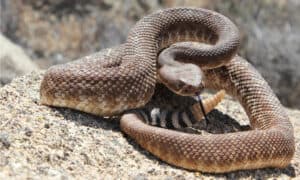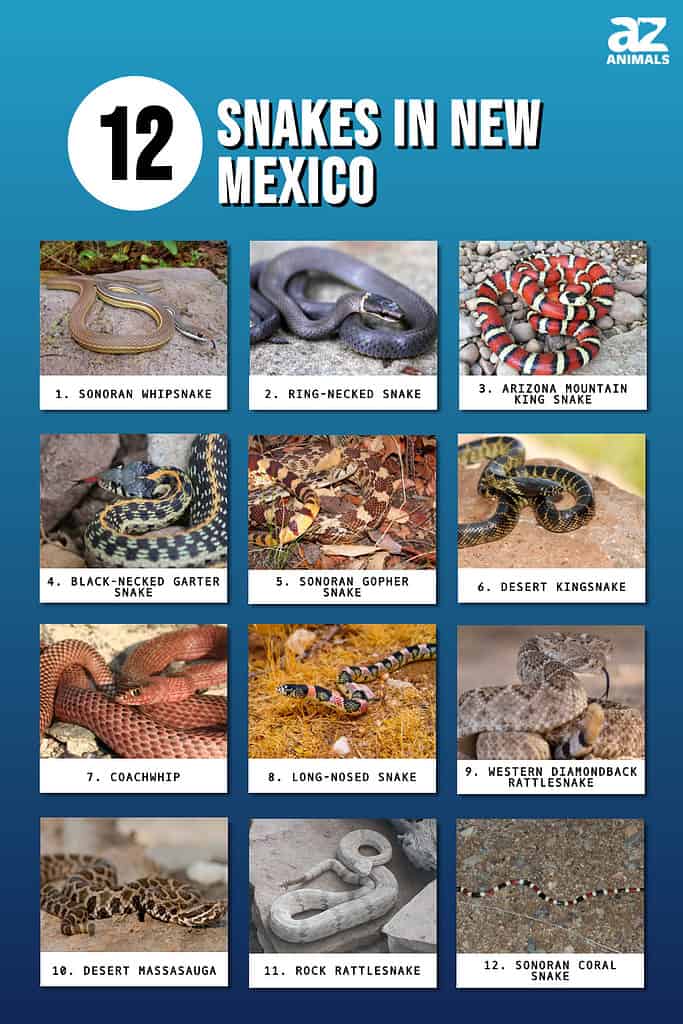
New Mexico’s terrain is varied. The miles of white sand desert, deep dark canyons, and ancient rocky mountains make it unique in the world. The Land of Enchantment’s landscape makes a fantastic home for thousands of species — including snakes.
With about 55 snake species in the state, New Mexico has one of the most diverse snake populations in the United States. However, only a few are venomous and, like almost all other snakes, want nothing to do with you.
Every part of New Mexico has at least a few snakes. Most avoid people and urban settlements, so there are more snakes seen out along the trails and in the mountains or deserts than in neighborhoods. We found 12 of New Mexico’s most interesting snakes, and a few of them may be common where you live.
1. Sonoran Whipsnake (Masticophis bilineatus)
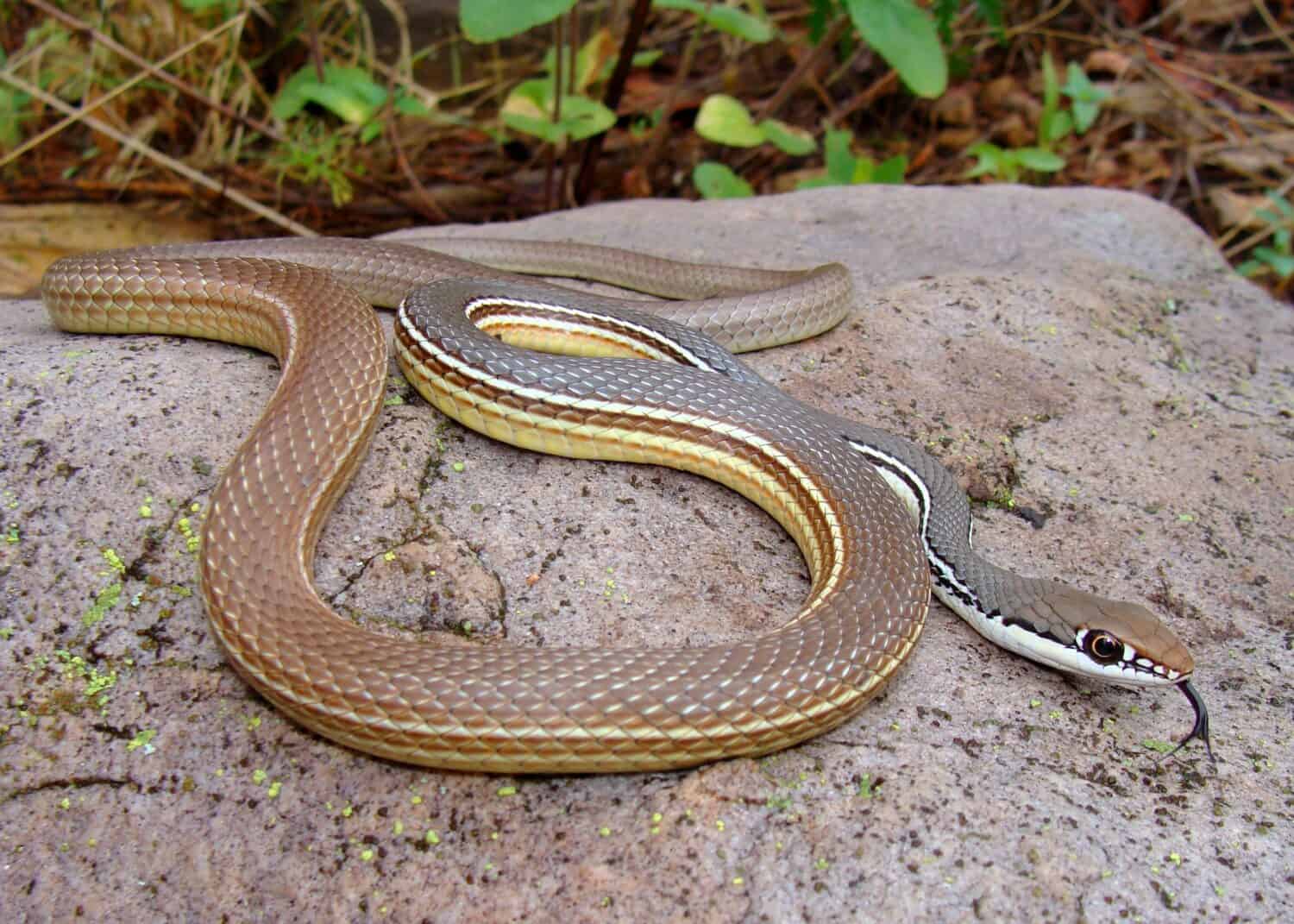
Sonoran whipsnakes are more of a Mexican species, but their range extends into Arizona and southwestern New Mexico.
©Matt Jeppson/Shutterstock.com
Like other snakes in the Masticophis genus, the Sonoran whipsnake is very slender, and adults typically measure between two and five feet long. They’re closely related to coachwhips, and their ranges often overlap. Sonoran whipsnake has large eyes and an olive-green to bluish-colored body that fades to yellow toward the tail with two or three lighter body stripes.
Sonoran whipsnakes are very fast and usually speed away from humans rather than stay close and risk a confrontation. These snakes prefer to live in canyons, rocky areas, mountains, foothills, and desert areas. They’re rare in New Mexico and only occur in the far southwest, but they are really interesting snakes!
2. Ring-Necked Snake (Diadophis punctatus)
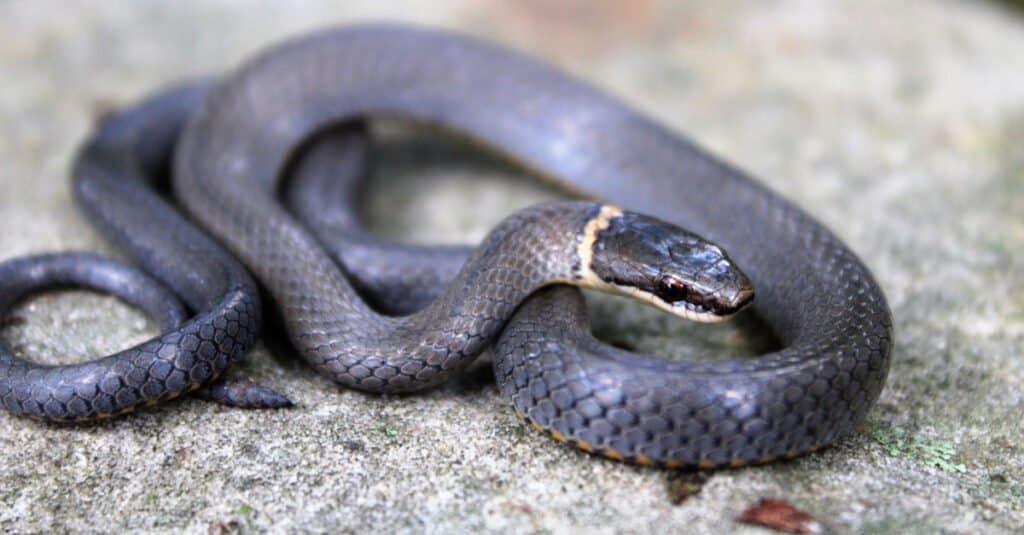
Ring-necked snakes (Diadophis punctatus) are nocturnal and hide under rotten logs or leaf litter.
©Tucker Heptinstall/Shutterstock.com
Ring-necked snakes are small and thin; most never grow longer than 15 inches. There are about 14 subspecies of these harmless snakes, but some scientists argue their validity and believe more research is needed before making a determination. Ring-necked snakes are common across most of the United States, and while they share similar body colors of gray, olive, brown, or black, their belly is always a lighter color that usually matches their neck ring. Their belly colors can be cream, yellow, orange, or red.
These snakes are most often found hiding under something, often in moist areas, because they eat soft-bodied insects and worms that also hide in moist areas.
3. Arizona Mountain King Snake (Lampropeltis pyromelana)
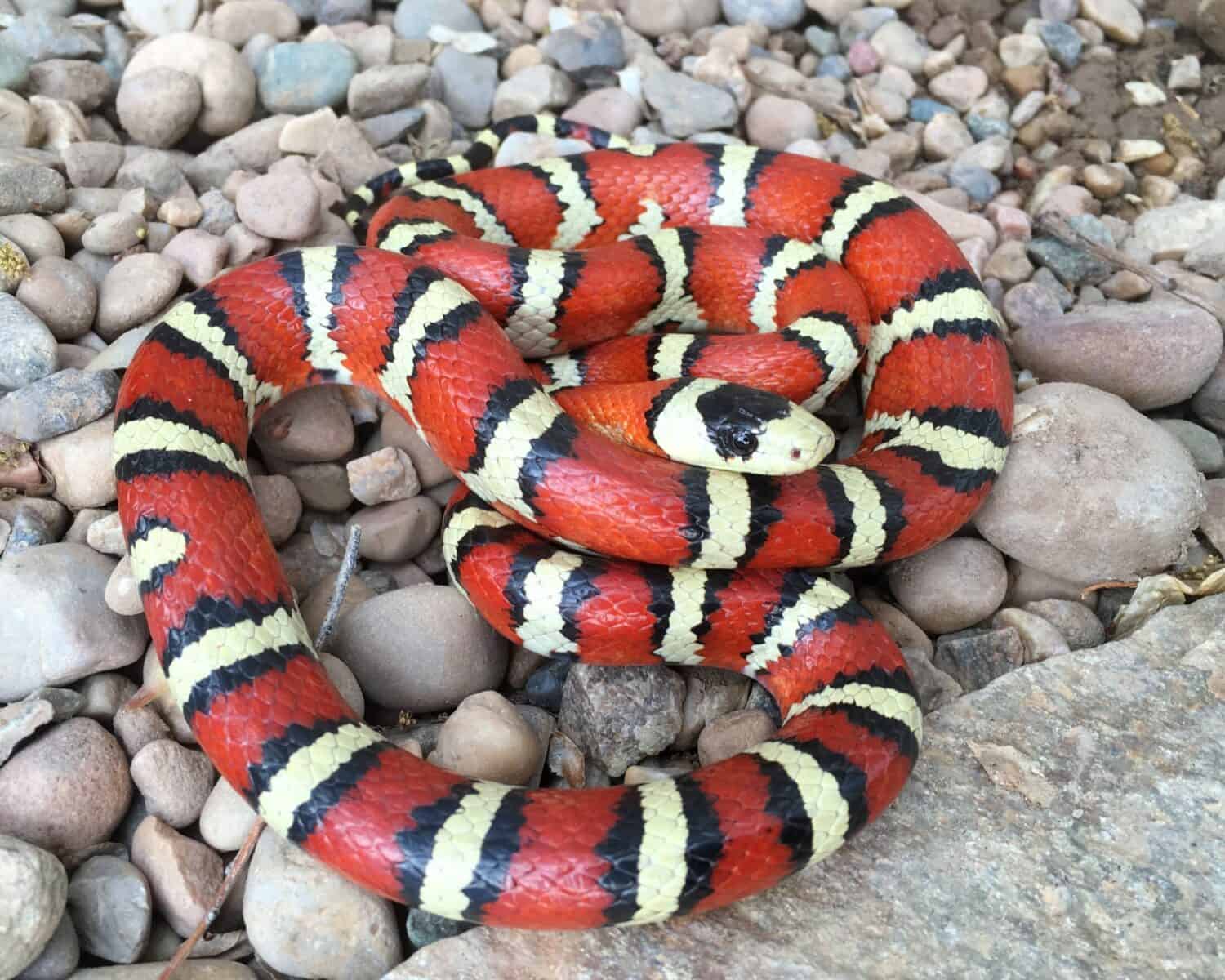
Arizona kingsnakes have bright red, black, and white bands all the way down their bodies.
©Matt Jeppson/Shutterstock.com
New Mexico has at least six king snake species. Three of them look similar, including the Arizona mountain kingsnake, western milksnake, and Chihuahuan mountain kingsnake. To add more confusion to the story, they also look similar to the Sonoran coral snake — one of the New World coral snakes, cousins to cobras and mambas.
Arizona mountain kingsnakes are most common in the southwestern corner of New Mexico and inhabit elevations between 3,000 and 9,000 feet above sea level. These snakes usually grow up to about three feet long and have red bands bordered by black with a white band between the black ones.
4. Black-Necked Garter Snake (Thamnophis cyrtopsis)
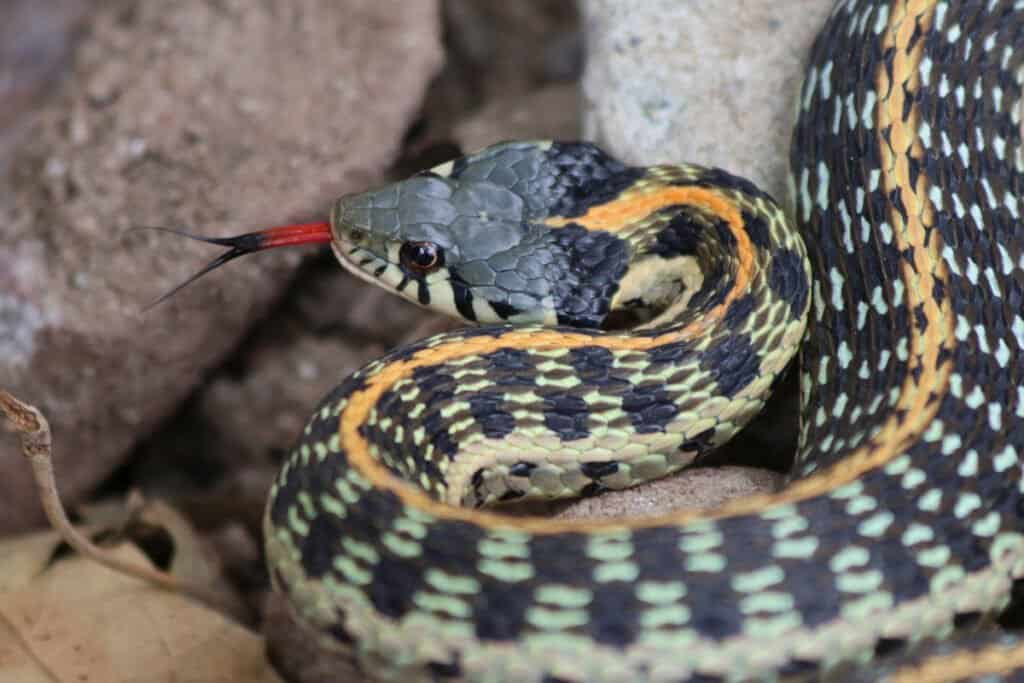
Black-necked Garter Snakes grow up to 42 inches long.
©Creeping Things/Shutterstock.com
The ever-adaptable garter snakes are also common in New Mexico. There are seven different garter snake species, plus a couple of subspecies.
Black-necked garter snakes are common in central New Mexico and south into Mexico. They have a yellow-orange dorsal stripe with a belly that’s cream or light gray and can grow up to 42 inches long. Like other garter snakes, black-necked garter snakes prefer living near rivers and lakes, where it eats tadpoles and small fish.
5. Sonoran Gopher Snake (Pituophis catenifer affinis)

Sonoran gopher snakes have slightly shorter noses than other gopher snake subspecies.
©Matt Jeppson/Shutterstock.com
This is the master bluffer of all North American snakes. When threatened, gopher snakes coil up like a rattlesnake and rattle their tail against the ground. Then, they puff themselves up, flatten their head, and hiss loudly — all in an effort to scare you off because they’re scared.
Gopher snakes are big and muscular, often six and sometimes seven feet long. In New Mexico, the Sonoran gopher snake is the most common subspecies. However, telling the difference between it and other subspecies means looking at its nose, which is shorter than other gopher snake subspecies.
6. Desert Kingsnake (Lampropeltis splendida)
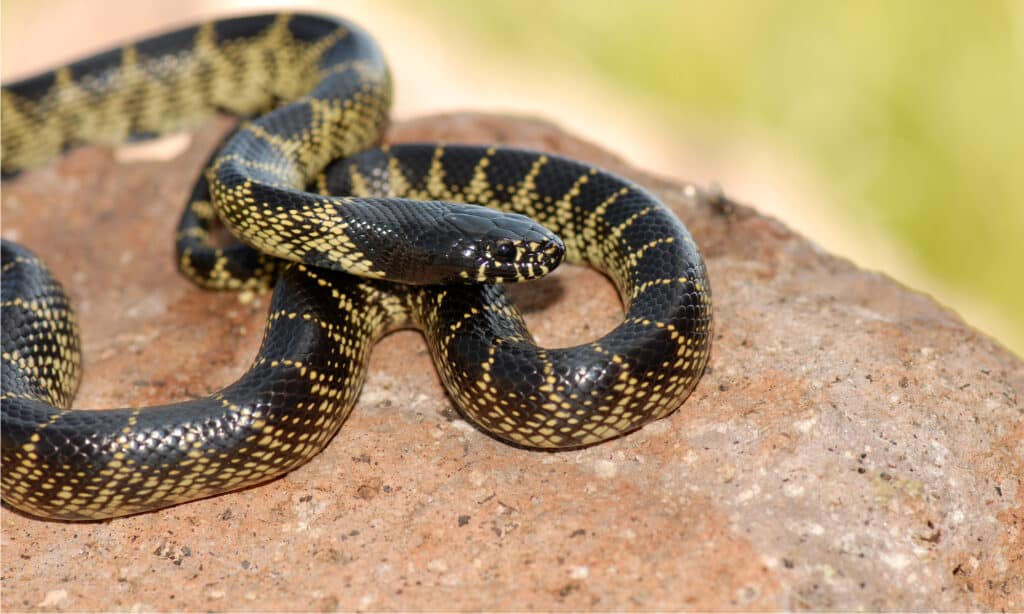
Desert Kingsnakes can grow to about six feet long, but usually stay much smaller.
©Rusty Dodson/Shutterstock.com
The nonvenomous desert kingsnake looks much like a speckled kingsnake, and their ranges overlap slightly. However, where the speckled kingsnake has yellow dots in the middle of almost all of its dorsal scales, the desert kingsnake has more black in its saddle markings.
Adults average between three and four feet long, although a few have managed nearly seven. Desert kingsnakes are docile and harmless. Some farmers and ranchers encourage them around their property because of the rattlesnake portion of their diet. However, they’ll happily eat small mammals like rats, mice, and rabbits too.
7. Coachwhip (Masticophis flagellum)
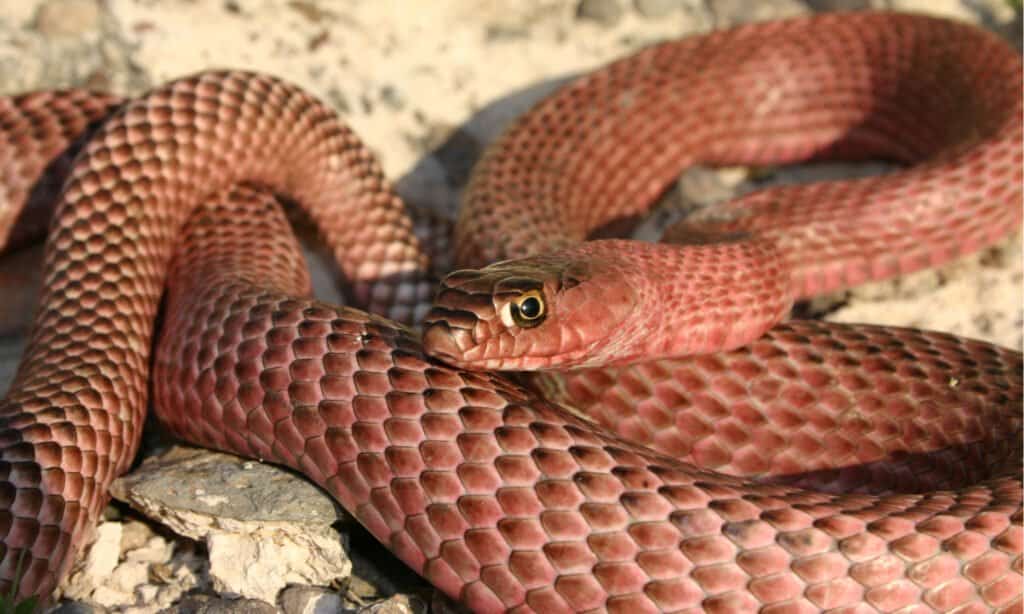
Coachwhip colors vary according to the habitat in which they live; they tend to match the colors around them.
©Nathan A Shepard/Shutterstock.com
These long and thin snakes are common across most of their range. Coachwhips are harmless and vary in color from pink to brown or even almost black. Regardless of which color they exhibit, it’s usually appropriate for the surrounding habitat. As young snakes, their pattern looks much like a rat snake but fades with age to its adult color.
Coachwhips often grow to six feet long, but the record was an eastern coachwhip — it was eight and a half feet long from nose to tail. This species eats a little bit of everything. They are daytime hunters that actively seek out lizards, small birds, and rodents; sometimes, they eat other snakes.
One curious habit they have is to “periscope” up to see what’s around. They have excellent eyesight and have been known to approach people, then take off at about four miles per hour.
8. Long-Nosed Snake (Rhinocheilus lecontei)
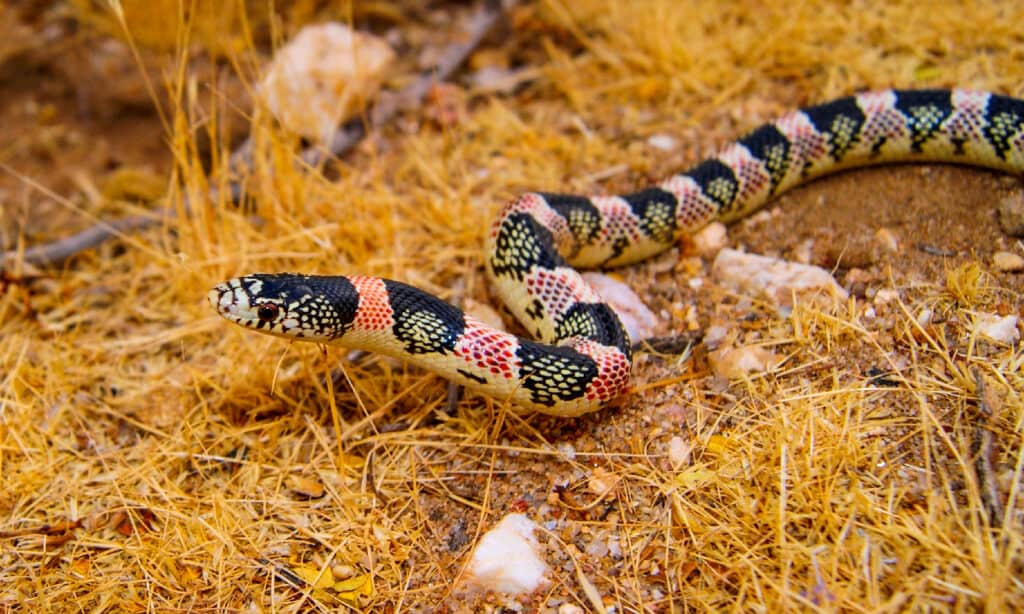
Long-nosed snakes have a slightly upturned snout that helps them burrow into the ground.
©Matt Jeppson/Shutterstock.com
You know that when people call you “long-nosed,” there may be an unusually long nose. As it turns out, the long-nosed snake doesn’t have a particularly long nose, just an upturned snout scale or three.
Long-nosed snakes are nocturnal and burrow, spending most of their time underground. Most people will go their entire lives, never having seen one in the wild. However, they’re not known to be endangered in New Mexico, just shy.
These snakes are only about 32 inches long as adults and have red and black saddle markings over a cream or yellow base color. With distinct cream-colored spots in their black saddles, long-nosed snakes are fairly easy to identify. Their diet includes lizards, amphibians, and sometimes smaller snakes.
Venomous Snakes In New Mexico
There are about ten different venomous snakes in New Mexico. Most of them are rattlesnakes — fearsome New World pit vipers. However, these snakes are, as the saying goes, more afraid of you than you are of them.
How is that possible?
It’s simple! Compare yourself to a rattlesnake — the biggest eastern diamondback you can find. An adult human male is still nearly times bigger. Yes, that snake can and will damage you, but in a fight with a human, the snake always loses.
Rattlesnakes are easily identified by the rattle, but juveniles only have a button where they’ll grow a rattle after a couple of shedding cycles. They also tend to look like someone ate the last of their Cheerios because of an extra scale over their eyes.
Some people try to kill them, but some evidence supports the idea that rattlesnakes control rodent populations better than birds or cats. If you don’t want them near your home, clear out everything they can use for food or shelter. Snakes don’t travel far, but they don’t stay where there’s nothing for them.
Here are a few of New Mexico’s venomous snakes:
9. Western Diamondback Rattlesnake (Crotalus atrox)
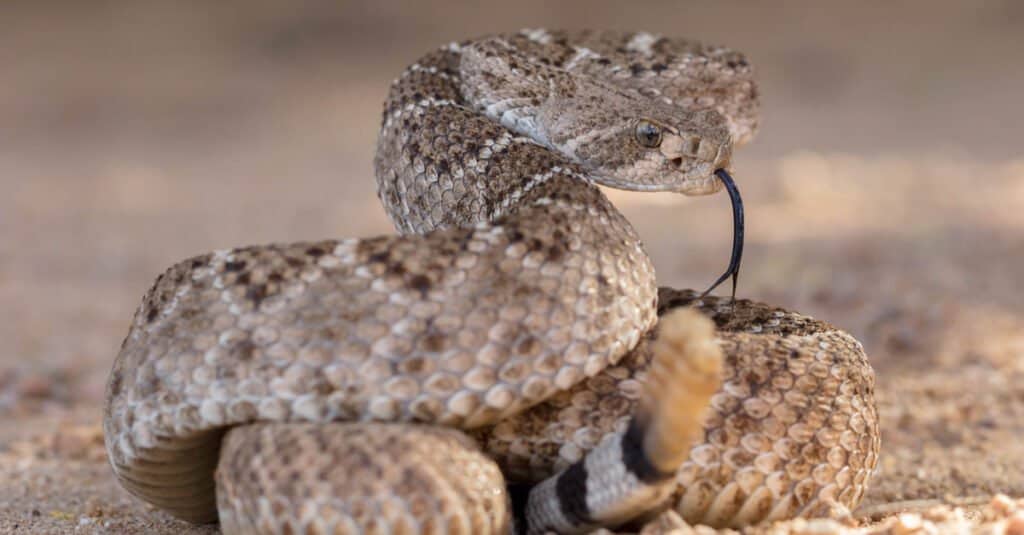
The Western Diamondback rattlesnake is found across the U.S. Southwest.
©Alexander Wong/Shutterstock.com
This is one of the most nervous and testy rattlesnakes of the bunch. If you’re going to get bitten by a rattlesnake in New Mexico, there’s a good chance it’ll be this one. Western Diamondback rattlesnakes are big, and they can grow to seven feet, but most are much smaller.
Western diamondback rattlesnakes have black and white bands on their tail, jagged diamond-shaped saddle markings, and often a darker stripe extending from their eye diagonally downward toward the back of their jaw. They have large heads with very thin necks and thick bodies covered in keeled scales.
Now, there’s no point in being afraid of these snakes. A healthy respect and understanding of them will prevent most bites. They are the definition of “I’m scared. I bite you.” Western diamondback rattlesnakes rattle early and loudly; they coil into an S position while they rattle, hiss, and try to back away. Let them.
10. Desert Massasauga (Sistrurus tergeminus edwardsii)
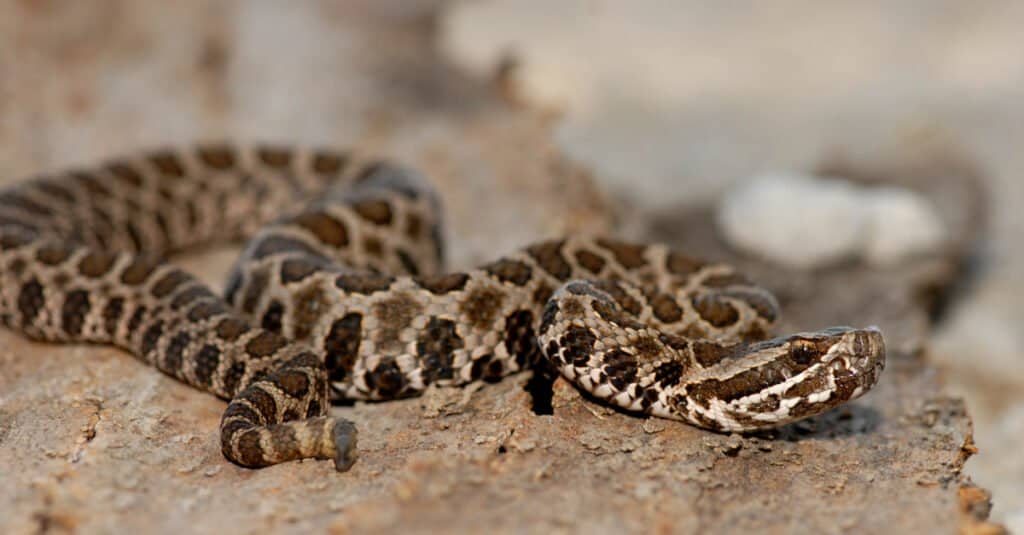
Western Massasauga rattlesnakes, like other pit vipers, can sense heat through pits located between their nostril and eye. They use this to catch prey.
©Rusty Dodson/Shutterstock.com
Desert massasauga snakes are a western massasauga subspecies and very small compared to other rattlesnakes. Most are only about 24 inches long, although they can grow a little longer. As rattlesnakes, their bodies are thick and covered in keeled scales. These shy snakes have small rattles that sound high-pitched, more like a buzz than a rattle.
They have oval saddle markings outlined in black, with alternating dark and light blotches on their sides over an even lighter gray or white base color. Like other pit vipers, they’re gifted with the ability to “see” or sense heat through pits located between their nostril and eye.
Desert massasaugas aren’t as terrified of the world as western diamondback rattlesnakes, so they sit there and hope you don’t see them. If you get too close, they’ll rattle. However, some snakes are more nervous than others, so you don’t know exactly how much warning they’ll give.
This snake mostly eats lizards, frogs, and rodents, using its camouflage to stay hidden until their prey is close enough to strike.
11. Rock Rattlesnake (Crotalus lepidus)
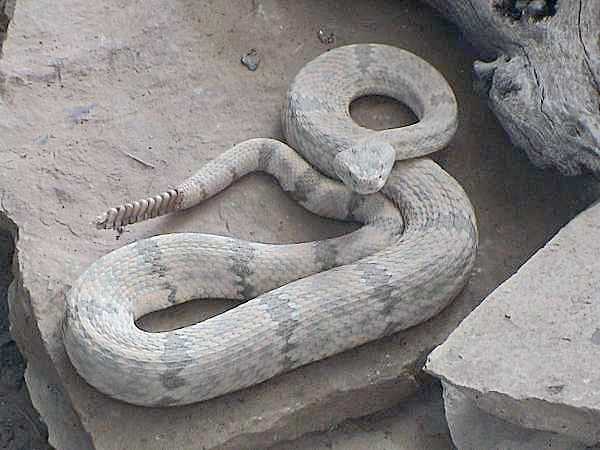
If bitten by a rock rattlesnake, hurry to see a doctor.
©Dawson / CC BY-SA 2.5 – License
This is a piece of living art. Rock rattlesnakes have light gray base colors and dark jagged-edged crossbands every few inches. A smaller species, they don’t usually grow any longer than 32 inches. When you get past the part about it being a scary venomous snake and really look, they’re beautiful. These snakes have well-developed rattles and match the rocks and deadwood where they live.
Rock rattlesnake venom is typically neurotoxic but also contains hemotoxins. Like other rattlesnakes, a rattlesnake bite is a medical emergency.
These snakes eat mammals, lizards, and frogs — they’re also active at cooler temperatures than other rattlers.
12. Sonoran Coral Snake: The Only Elapid in New Mexico
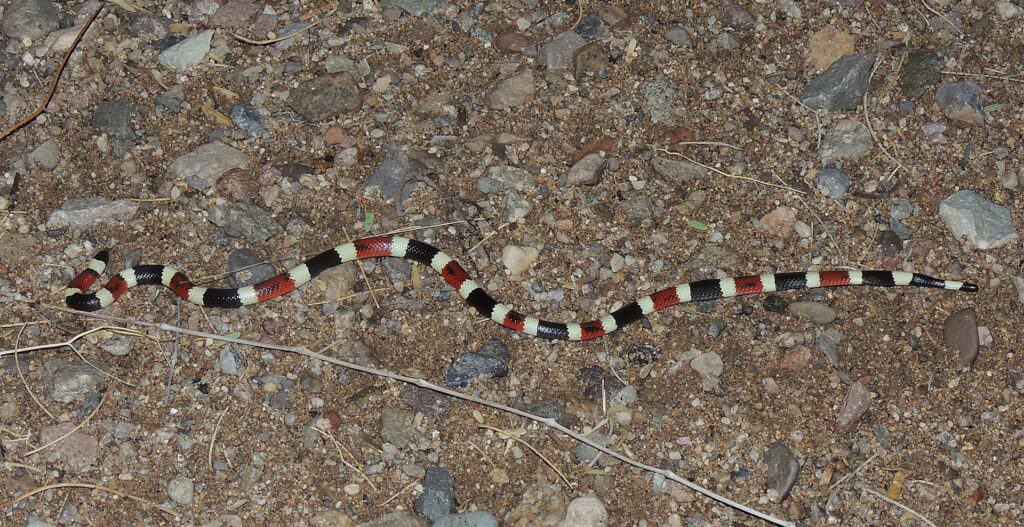
Although they’re extremely venomous, Arizona or Sonoran coral snakes only reach 11-24 inches in length
©CC BY-SA 2.0
The Sonoran Coral snake stands out no matter what habitat it’s in. You won’t miss the wide red and black bands that cover the snake from head to tail. Between the red and black bands are pale yellow or cream-colored bands. If you’ve seen an eastern or Texas coral snake, the Sonoran coral snake almost looks like it’s not even a coral snake. However, there’s a wide cream or yellow band right behind its eyes — a common characteristic of North American coral snakes.
All coral snakes are highly venomous, and a bite from one may not show symptoms right away. But the neurotoxins contained in their venom can eventually cause heart and respiratory failure. Although antivenom production had ceased for several years, that changed, and the pharmaceutical company Wyeth began producing it again, and it’s part of the accepted treatment for North American coral snakebites.
Happily, these snakes are shy and not overly jumpy. Coral snakebites are less than one percent of all venomous snakebites in the U.S. every year, and if you give them space, they’ll probably move along.
Summary of 12 Snakes In New Mexico
Here are 12 different snakes found in New Mexico:
| Rank | Snake Species |
|---|---|
| 1 | Sonoran Whipsnake (Masticophis bilineatus) |
| 2 | Ring-Necked Snake (Diadophis punctatus) |
| 3 | Arizona Mountain King Snake (Lampropeltis pyromelana) |
| 4 | Black-Necked Garter Snake (Thamnophis cyrtopsis) |
| 5 | Sonoran Gopher Snake (Pituophis catenifer affinis) |
| 6 | Desert Kingsnake (Lampropeltis splendida) |
| 7 | Coachwhip (Masticophis flagellum) |
| 8 | Long-Nosed Snake (Rhinocheilus lecontei) |
| 9 | Western Diamondback Rattlesnake (Crotalus atrox) |
| 10 | Desert Massasauga (Sistrurus tergeminus edwardsii) |
| 11 | Rock Rattlesnake (Crotalus lepidus) |
| 12 | Sonoran Coral Snake: The Only Elapid in New Mexico |
The photo featured at the top of this post is © Joe McDonald/Shutterstock.com
Discover the "Monster" Snake 5X Bigger than an Anaconda
Every day A-Z Animals sends out some of the most incredible facts in the world from our free newsletter. Want to discover the 10 most beautiful snakes in the world, a "snake island" where you're never more than 3 feet from danger, or a "monster" snake 5X larger than an anaconda? Then sign up right now and you'll start receiving our daily newsletter absolutely free.
Thank you for reading! Have some feedback for us? Contact the AZ Animals editorial team.





